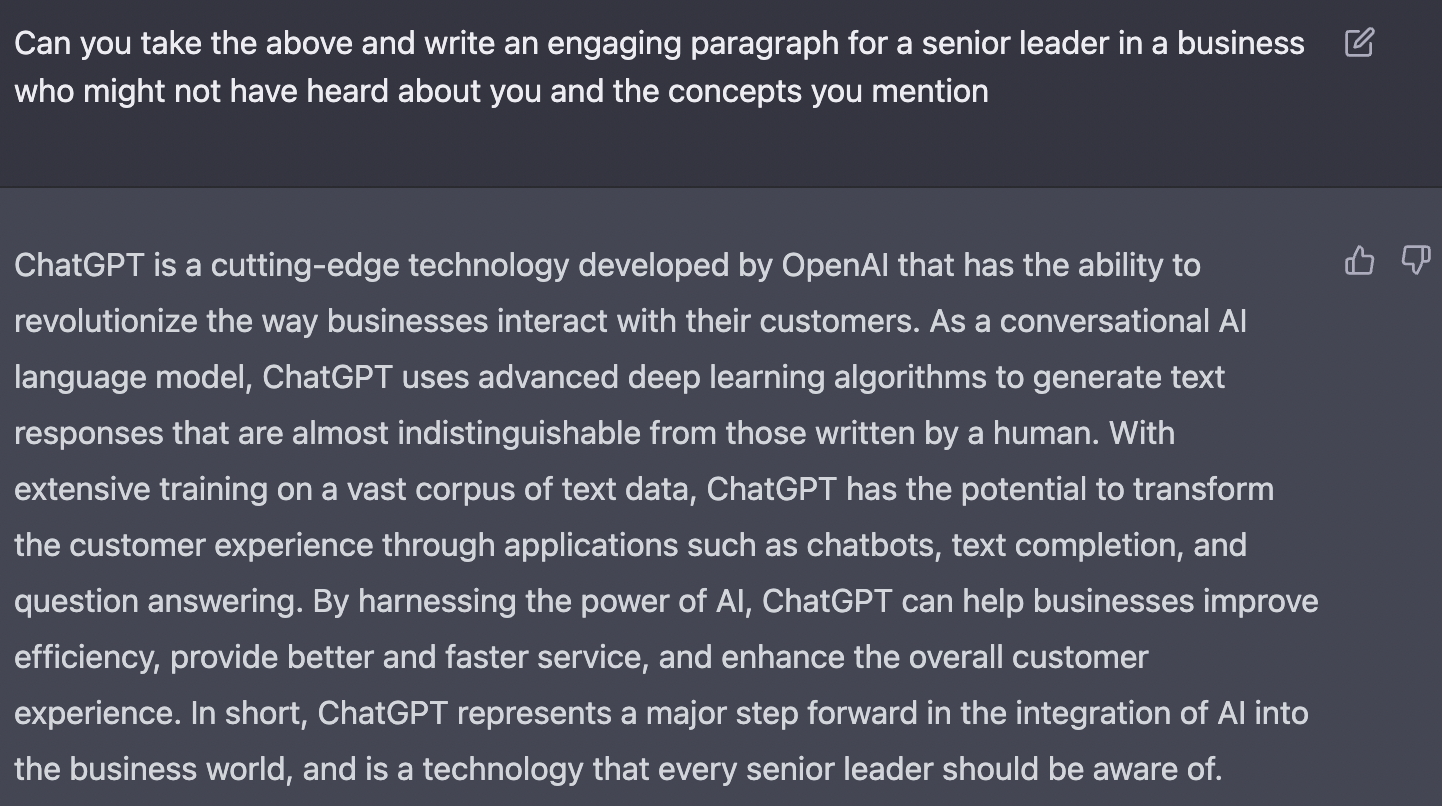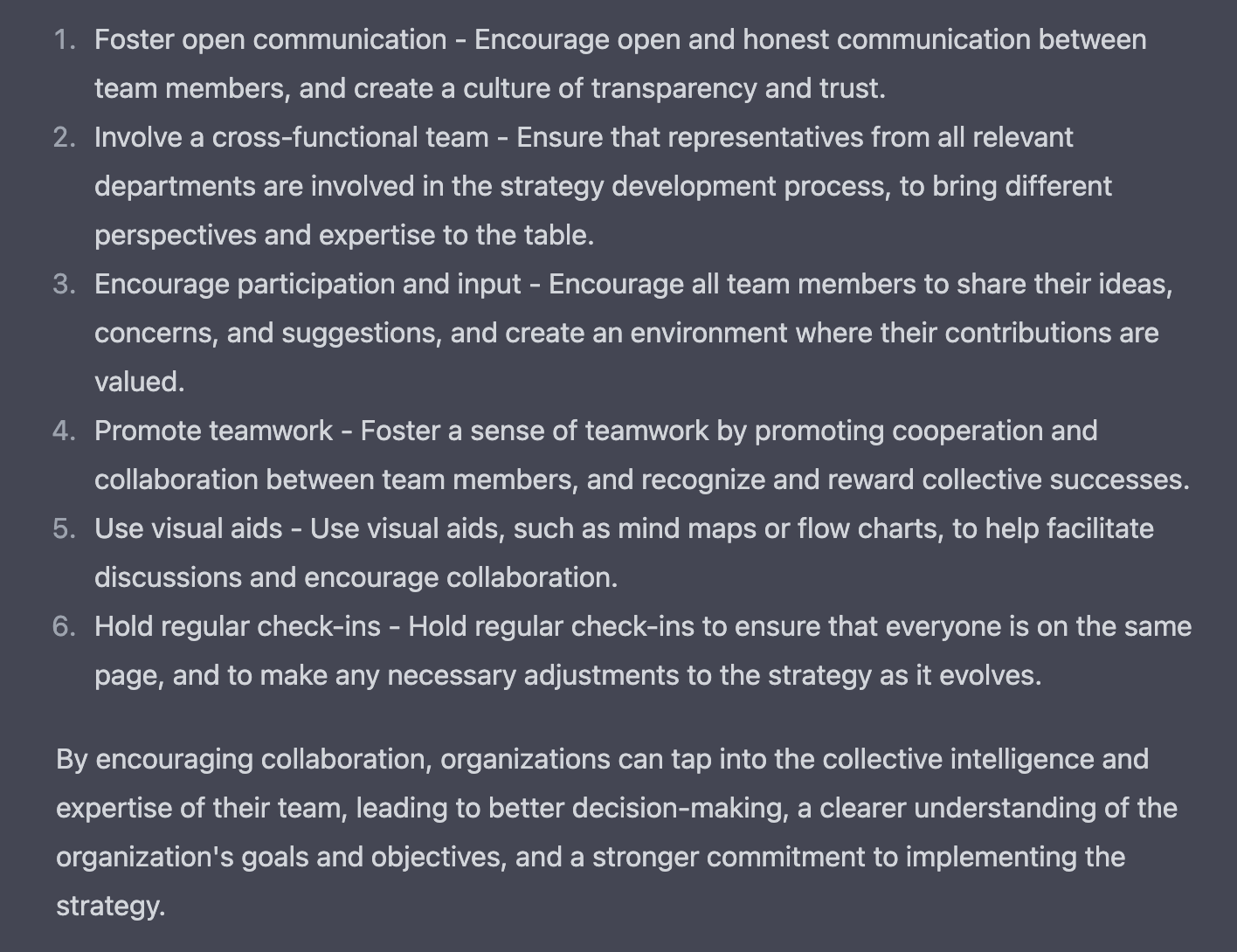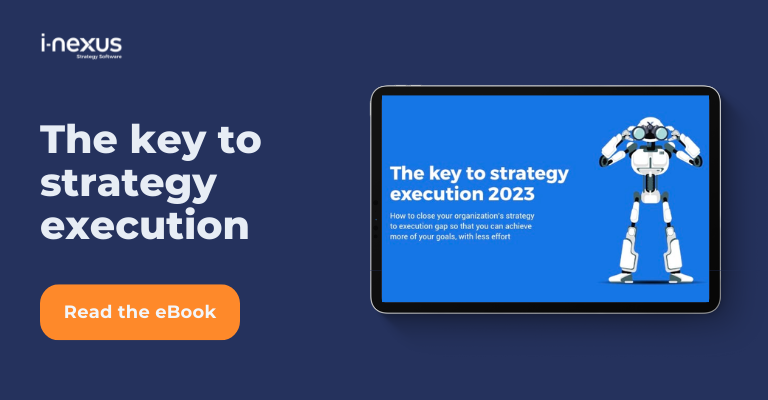As more and more AI solutions come to market, ChatGPT has taken the lead with its ability to answer seemingly any question - but can ChatGPT help you create your strategy?
In early 2020, the conversations around the role of machine learning (ML) and artificial intelligence (AI) in our everyday lives started to gain real traction.
With that growth, we turned and answered how AI will evolve for machine-assisted strategy execution. While an exciting look at the future, that future felt far away.
As I sit here and take you on a journey, it's important to remember that the role of change is not to dislodge our role in business, but to disrupt our ways of thinking. While we often resist change, in the end, that change is a catalyst for something better.
“The greatest danger in times of turbulence is not the turbulence – it is to act with yesterday’s logic.”
Peter Drucker
Read on to learn what ChatGPT is, some interesting examples of what ChatGPT is being used for, and, above all else, whether ChatGPT can create your next strategy.
What is ChatGPT?
ChatGPT has taken the world by storm.
Introduced in 2020 as part of an effort to open up access to and drive greater collaboration and growth in the world of artificial intelligence, it has increased in popularity. It can be found in LinkedIn posts, blogs, YouTube videos, and part of the water cooler talk.
But the great thing about ChatGPT is that I don't have to define ChatGPT for you because with a few straightforward instructions into the conversation, we can go from a standard answer like this:
"ChatGPT is a conversational AI language model developed by OpenAI. It uses deep learning algorithms to generate human-like text responses based on the input it receives. ChatGPT is trained on a large corpus of text data and can be used for various applications such as chatbots, text completion, and question answering."
To this:

It really is that powerful.
What is ChatGPT used for?
ChatGPT has come with plenty of use cases across the board.
Here are some examples of how it can help:
- Mathematical questions
- Produce proof of concepts
- Ideate
- Proof code
- Write long-form content like essays and reports
An exciting concept gaining tracking is using ChatGPT for mind maps.
What does ChatGPT not do?
Because the system is based on learning from countless data points, much like Wikipedia, there is a hefty disclaimer that must be put against anything that comes from the results.
ChatGPT can be an excellent starting point, but it isn't the complete answer to all your problems.
As ChatGPT tells you itself, it's not great at:
-
Original thinking or independent decision making
ChatGPT can only generate responses based on the patterns it learned from the training data; it cannot think or make decisions independently. -
Understanding emotions or sarcasm
ChatGPT cannot understand emotions or sarcasm and may respond inappropriately in certain situations. -
Contextual awareness
ChatGPT cannot maintain a complete understanding of the context of a conversation; it can only generate responses based on the input it receives at a given time. -
Physical tasks
ChatGPT is a language model and cannot perform physical tasks. -
Consistent accuracy
While ChatGPT has been trained on large amounts of data, it's inaccurate and may generate incorrect or nonsensical responses in certain situations.
Why is ChatGPT a positive addition to our lives?
But while there are these shortcomings, it's important to see the benefits of using ChatGPT in our businesses:
-
Improved efficiency
ChatGPT can handle a large volume of interactions quickly and accurately, enabling businesses to improve their response time and provide better customer service. In fact, the more you interact you can train ChatGPT to learn about your tone and become an AI assistant. -
Enhanced customer experience
ChatGPT can generate human-like responses that are personalized and relevant, helping to enhance your overall customer experience, and could easily be used as part of a chat flow on your website or triaging, as brands like Xfinity make great use of. -
Increased productivity
By automating tasks, such as answering frequently asked questions or generating a transcript from your recent presentation, ChatGPT can free up staff time for more complex and creative tasks, increasing productivity. -
Scalability
ChatGPT can handle a large volume of interactions simultaneously, making it an excellent tool for start-ups to enterprise-scale organizations. -
Continuous improvement
With its ability to learn from its interactions and improve over time, ChatGPT has the potential to improve its performance and provide even better results continually.
Can ChatGPT create your strategy?
In short, no.
If we look back at the third item on the list of "what does ChatGPT not do?" we come to the heart of the artichoke - ChatGPT lacks contextual awareness.
Lack of situational understanding prevents ChatGPT from creating a corporate or functional or departmental strategy for your organization.
Here's what ChatGPT will struggle to do when tasked with creating your strategy:
- It cannot form a deep understanding of your environment - markets, competitors, suppliers, and much more are vast and different in their value and role in your organization's success
- An internal analysis of your strengths and weaknesses using a tool such as VRIO requires an expert to collate, analyze, prioritize, and act on the information found
- Provide creative thinking about taking information on the above and help you generate a clear path forward
However, you can ask for advice on how to conduct each step of creating your strategy, and it can generate reports and summaries of the information provided.
Whether you're an innovator, analyst, or decision-maker, you will always need great leaders to steer your organization.
ChatGPT should be used with human expertise and decision-making rather than as a substitute in your strategy creation process.
Here's how you can do that.
How can ChatGPT be used to create your strategy?
If we change our approach to ChatGPT to see it as a tool to assist in creating your strategy, there are numerous examples that you can use the tool for across the strategy creation lifecycle.
Getting started
A use case for ChatGPT is a search engine. In that light, you can easily ask the AI to provide you with a list of tools and frameworks you should consider when mapping and analyzing your company's internal and external environment.
Here's what ChatGPT suggested, with a useful explanation of the use next to the name:
-
SWOT analysis - is used to analyze a company's internal strengths and weaknesses and its external opportunities and threats.
-
PESTLE analysis - is used to analyze a company's political, economic, social, technological, legal, and environmental factors.
-
Competitive analysis - is used to analyze a company's competitors, their strengths and weaknesses, and their market position.
-
Customer analysis - is used to analyze a company's customer base, including demographics, purchasing habits, and feedback.
-
Market research - is used to gather data on a company's target market, including size, growth rate, trends, and customer preferences.
-
Financial analysis - is used to analyze a company's financial performance, including revenue, profit margins, and cash flow.
With these tools on your bucket list, you can identify guides and templates to help you conduct the analysis, such as that i-nexus offer:
Strategic advisory
Moving beyond the strategy creation tools themselves, ChatGPT can offer a basic-level strategic advisory service to business leaders. Even keeping in mind that the answers provided will not be unique to the person asking the question, the tool is helpful for ideation.
For example, I explained to ChatGPT a scenario where I'm struggling to align leaders with our direction and that I felt I needed some ideas for improving the way we're collaborating.
Here's what ChatGPT came back with:

While the answers are not original, for those leaders looking for quick answers to their challenges in strategy creation, ChatGPT is capable of basic strategic consulting.
However, as with all that ChatGPT creates, it's important to note that these answers' accuracy, bias, and quality cannot be guaranteed.
Communicating your strategy
While ChatGPT isn't going to create your strategy, it can help communicate that direction.
By asking ChatGPT that very question, ChatGPT will respond with some basic information to get started:
- Audience
- Length
- Theme
- Key messages
While this isn't a replacement for great storytelling, as covered in our key to strategy execution eBook, it does give you a starting point for creating and tweaking a talk track for your presentations.
I provided this information:
- Topic: Creating a strategy that leverages AI
- Audience: Shopfloor workers
- Length: 15 minutes
- Key Messages: 1) AI is here to help us be more creative, 2) Our market has yet to leverage AI to help with production, 3) AI training and support will be given
I asked ChatGPT to create a talk track for a presentation that covers leveraging AI for our strategy; here's what came back:
- Introduction (1 minute):
- Greet the audience and introduce yourself
- Briefly explain the topic of the presentation and why it's important
- Importance of AI (3 minutes):
- Explain how AI is becoming increasingly important in the business world
- Highlight some of the key benefits of AI, such as increased efficiency and accuracy
- Emphasize that AI is not meant to replace workers but to assist and support them
- Our Market's Potential for AI (5 minutes):
- Discuss the current state of the market and the role that AI can play in it
- Explain that there is a significant opportunity for your organization to leverage AI to improve production
- Use real-life examples or case studies to illustrate your points
- Benefits for Shopfloor Workers (4 minutes):
- Highlight how AI can help shopfloor workers be more creative and productive
- Explain how AI can provide workers with new tools and resources that they can use to improve their work
- Emphasize that AI is an exciting addition to the workplace and that workers will have access to training to help them make the most of it.
- Conclusion (2 minutes):
- Summarize the key points of the presentation
- Reiterate the importance of leveraging AI to improve productivity and enhance the workplace
- Thank the audience for their attention and invite any questions or comments.
Again, the key with ChatGPT for your strategy is to take the output as a starting point. This talk track can then be altered and used as the basis to plan out the presentation.
ChatGPT isn't ready to create your strategy
ChatGPT isn't ready to create your strategy; perhaps it will never be.
But that isn't where the value of ChatGPT lies.
ChatGPT is the beginning of change, and it's an opportunity for business leaders (budding and established) to leverage this tool for good.
While it doesn't always provide accurate answers, it offers a starting point.
From templates to basic advisory work, ChatGPT is built to give you back time on your journey and provides just enough to help you focus on what matters - your input.
For more on taking your strategies and effectively executing them, download a copy of our key to strategy execution eBook.
Learn more about strategy creation
Take the next steps in your journey by exploring our strategy execution resource hub or any of the below:
- Key to strategy execution eBook: Read how companies like Danaher and HP have mastered strategy execution and what you can learn from them.
- What does it mean to be Business Agile?: Leap into the future of strategic planning and execution with this fascinating insight.
- How AI and Machine-Assisted Learning will help strategy execution: As Artificial Intelligence becomes a mainstay in our lives, read how AI and machine-assisted learning will evolve to support your strategy execution.
About the author
James Milsom is Head of Marketing at i-nexus.
As Head of Marketing, he aims to raise awareness and understanding of enterprises' challenges in delivering strategic objectives and transformation amidst changing markets and the obstacles traditional tools and methods present leaders.
If you’d like to talk more about strategy, reach out to James at james.milsom@i-nexus.com or connect with him on LinkedIn for the latest insights.



.jpg?width=352&name=KPIs%20(3).jpg)